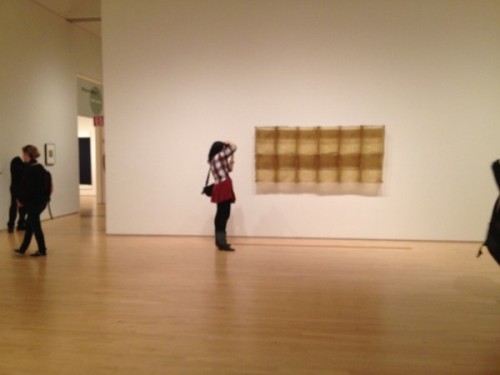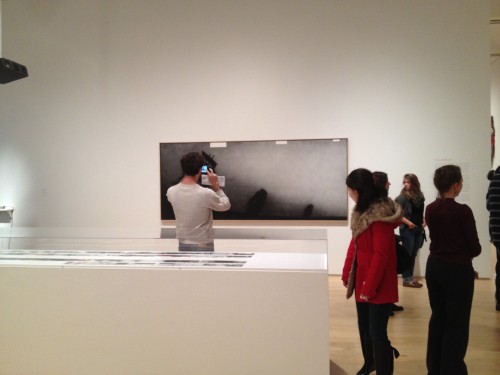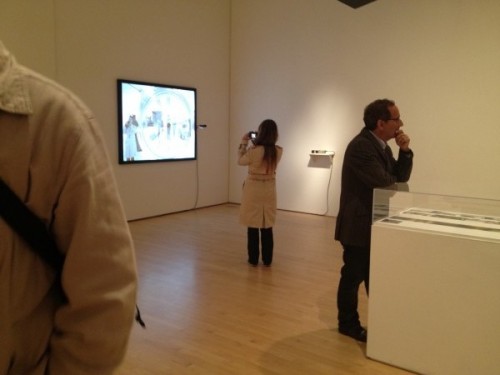May 02, 2012
EMANCIPATED SPECTATOR(s)
I’ve come to enjoy the phenomenon of the digitally connected spectators which make up the modern museum audience. At times I want to be critical and stand on my imaginary podium to speak about this and the loss of our biological connection with our environment. But this loss is accompanied with an ease of communication with others via social networking and blogging.
Is this new digitized life so integrated that even to take photos of these digital spectators is to be a “digital spectator”?



Comments (7)
-
konrad says:
June 13, 2012 at 10:01 am
-
Brandon says:
June 11, 2012 at 8:30 pm
-
konrad says:
June 11, 2012 at 1:05 pm
-
Brandon says:
June 10, 2012 at 6:22 pm
-
Christine Wong Yap says:
May 3, 2012 at 4:50 am
-
Charlene Tan says:
May 2, 2012 at 4:34 pm
-
Nick says:
May 2, 2012 at 11:06 am
See all responses (7)There’s no denying loss of various kinds of contact with the work and with others in the free “flower arrangements” that people make of their gathered bouquets of imagery. In the same vein, my pet peeve (naturally as a filmmaker) is people saying they’ve “seen that” when they’ve watched it on YouTube. Seeing films in a group is the best way to watch, IMHO.
But at the other end of the interaction with these “digital samplings” of artifacts, there is the casual observer of that arrangement, for whom there can be the novelty and discovery of seeing meaning in the contact between images themselves. Dare i say this is a relative of the dérive?
This is all very true. The work can now be taken out and repositioned freely, where as before we had to rely on finding images outside the museum. But for me it’s still more or less the same issue and loss of info, participation and concentration. I personally dislike tumblr’s and find them to be void of anything but visual stimulation. Which isn’t that bad in certain instances, but when it just comes to things being snatch and rearranged with no thought what so ever, it becomes an issue.
There’s the urge to acquire/capture the image, and the urge to decry the loss of extended contact. I feel both of these, but i wanted to add something that hasn’t been mentioned.
One effect of our ability to spirit an image away from its situation is to be able to see an object represented in a new context. In effect one can adopt the role of the curator who arranges the images in a collection to create meaning by juxtaposition. Or the role of the montagist: if there is a story that any film editor will tell you, it is the one about the serendipity of putting two images (or songs) near each other accidentally and finding powerful meaning in the joinery.
So this does enable new kinds of discovery.
In other words, the reason for Tumblr’s popularity.
This is a nice post Char. The thing that gets me miffed (if anything) is the eventual breakdown or lose of attention. That this image becomes another image, stored with another image, to possibly be deleted to make room for another image. The number of notebooks that one use to see were attached to viewers who may or may not have wanted to snap a pic, but couldn’t. But with this new advantage is the loss of a possible discovery. that as the time that was spent with the work sketching it, taking notes, staring at it has now been replaced with making sure the image isn’t blurry, that you caught more than one angle or that you got one with and without the flash to see the color difference. Basically the time spent imaging the work is now simplified making it that any possible discovery between you and the work is quite possibly gone. Its amazing to have a picture of something you might not see again, but it’s also amazing to have that memory of seeing it, spending time with it, but also maybe having a sketch and notes that hold all of that.
Digital life can seem integrated, but it can also be highly fetishized and addictive. As you wrote, it’s easy to rail against viewers who mediate their own firsthand experiences; it seems especially ironic to do so in an institution dedicated conserving and presenting art objects for direct encounter. At the same time, no one wants to be told how to view art or record and share their aesthetic experiences.
It’d be interesting to hear more about digital spectatorship, and what that entails. Can images supplant aesthetic experiences, and to what extent? What are the implications for objects, for embodied experiences? How much or little interaction constitutes engagement?
It seems like you’re saying that ease of communication via social media counterbalances the loss of first-hand experience. I’ve seen reports on psychological studies indicating correlations between social media and narcissism, Facebook and unhappiness, so I’d question the suggestion that communication is inherently beneficial, e.g., the use of social media necessarily strengthens social connection. I’m not sure that it does. (And yes, I realize the irony of trying to have this discussion on a blog!)
great post!
I am intrigued by part of the New York Times quote, “…the camera is a way of connecting, participating and collecting fleeting experiences.” It reminds me of an experience I had exploring the Louvre several years ago, when I was confronted by a man with a video camera and a mission. A mission to document the entire collection of the Louvre in a silent video tour. At the time I dismissed it as tourist theatrics but after spending 6-7 hours wandering the galleries I wish I had asked for a copy of his video tour.
People have always tried to capture what they see at museums though. I don’t see as many notebooks or easels as I used to but a lot of the photography is the same thing.
And for people like me who view museums as an opportunity to people watch, it’s only natural to photograph people as they interact with the art.
http://njwv.wordpress.com/2011/09/12/museum-photography/